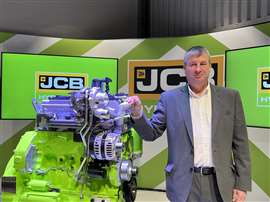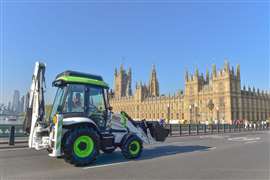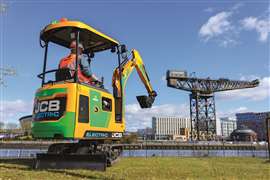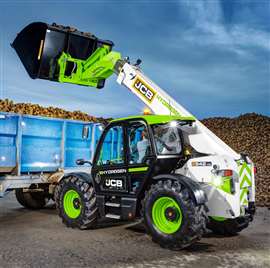Read this article in French German Italian Portuguese Spanish
Looking beyond diesel, how does JCB see use cases for hydrogen and electric?
21 May 2025
 JCB’s Tim Burnhope (Photo: JCB)
JCB’s Tim Burnhope (Photo: JCB)
JCB didn’t miss an opportunity to publicise the fruits of its £100 million (US$133.7 million) investment in hydrogen combustion engines, after changes to UK law made hydrogen-powered construction and agricultural machines legal on UK highways earlier this month.
The company paraded a green, hydrogen-powered backhoe loader past the Palace of Westminster to mark the legislative change.
Meanwhile, the company now produces nine different lines of pure electric machines, including mini excavators, compact dumpers and telehandlers. It recently passed 35,000 unit sales across all electric machine types, according to Tim Burnhope, the company’s group director of special projects.
Diesel-powered machines may still make up the vast majority of units sold by the OEM, but it is gradually growing the range of machines it offers that run on lower-carbon, lower-emission energy sources.
So how should construction companies choose between a hydrogen-fuelled machine and one running off battery-electric power?
The case for hydrogen
Speaking to Power Progress International’s editor Julian Buckley, Burnhope says the case of hydrogen as a fuel for construction machines needs to be carefully managed.
“When it comes to hydrogen and rationalising the use case, you have to start with the job site and work back from there. The case for hydrogen is much more compelling from that perspective,” he explains.
 JCB drove a hydrogen-fuelled backhoe loader past the Palace of Westminster to celebrate a change in legislation that allows hydrogen-fuelled construction and agricultural machinery to use UK roads (Image: JCB)
JCB drove a hydrogen-fuelled backhoe loader past the Palace of Westminster to celebrate a change in legislation that allows hydrogen-fuelled construction and agricultural machinery to use UK roads (Image: JCB)
“The global population will be growing in regions outside Europe and unlike here, a lot of this growth will involve greenfield projects – there’ll be no infrastructure, no power cables. But what a lot of those countries have is solar power and that electricity can be used to produce hydrogen on the site.”
He gives the example of Saudi Arabia’s $500 billion Neom, the mega construction project in Saudi Arabia which includes such elements as horizontal skyscraper known as The Line and a mountain holiday retreat called Trojena. Across each of these locations the plan is for the infrastructure to be self-sustaining in terms of energy, which could see electricity from renewable solar and wind used to produce hydrogen.
“That will work well in places like Saudi Arabia. But in Britain, where the sun doesn’t always shine and there’s not always any wind, stored renewable electricity can be used to produce green hydrogen to deliver power where and when it’s necessary,” says Burnhope.
He continues: “I don’t say it’ll be one energy source or another across the entire industry, but we’re likely to see different energy sources for different applications, electric for compact machines, hydrogen for larger machines and perhaps biofuels for the very large mining and quarrying machines. It’s all about using the right energy type to deliver what’s needed.”
Because it is difficult to predict future demand for hydrogen technology accurately, JCB has ensured that it can produce its hydrogen internal combustion engine in any sequence and in any volume on the same assembly line delivering the four-cylinder 55 kW diesel engine on which it is based.
Likewise, machines on the same assembly line can be fitted with either diesel or hydrogen engines. “It’s very similar to engine manufacturing. Where we are producing backhoe loaders, instead of dropping in a traditional diesel engine and fuel tank the machines can be fitted with a hydrogen pressure tank, the fuel delivery system and the H2 engine on the same line,” Burnhope explains.
The use case for electric machines
Meanwhile, electric construction machines are ideal for use on sites where there is either reliable access to electricity for charging, or where the machines can be taken back to a depot for charging.
 One of Sunbelt’s JCB electric mini excavators, pictured on the Clyde River in Glasgow, Scotland.
One of Sunbelt’s JCB electric mini excavators, pictured on the Clyde River in Glasgow, Scotland.
Given the right connection, charging can be quite rapid. The machines themselves are also quiet, which makes them suitable for work on enclosed urban sites and underground locations.
While smaller machines lend themselves to battery power, using the same tech for larger applications raises a series of issues. Battery pack size, recharging and purchase cost are all prohibitive.
Burnhope says, “It all sounds very good, having the capability to recharge in an hour. But sometimes you can’t get power delivered at that level, plus you need a pretty heavy cable to support charging at those rates. That’s when you end up with diesel generators on site, which defeats the objective.”
And he gave the example of the following use case, “A 20-tonne electric excavator can have between 200 and 400 kWh of batteries. One scenario we’ve modelled is where you have a machine like this that supports battery swapping, but you need a 16-tonne truck to carry the eight tonnes of batteries to and from where they’re charged. Plus you need another set of batteries on charge and at least two operators. Including the cost of the excavator, you could be looking at around £1 million, where a diesel version of the same machine is about £150,000.”
That indicates that unless absolutely necessary, the cost/benefit of large electric machines does not add up.
Crunching numbers
Nonetheless, proponents of electric machines argue that while they are expensive to buy, the lower cost of electricity over diesel (in some areas) will see the advantage swing back to battery models over a machine’s working lifetime.
“I think total cost of ownership numbers are good, but that doesn’t take into account some of the challenges,” says Burnhope. “Residuals are important. And that is impacted by the expected number of recharging cycles. For mini electric machines, those batteries will last a long time. For larger machines, prospective customers are asking if they will need to buy new lithium batteries in 10 years and that would be expensive.
“That’s why machines with lead-acid batteries were popular – the batteries didn’t offer a great run time and they would wear out, but they were cheap to replace.”
JCB’s new US factory
JCB hit the headlines in April after announcing, amid a flurry of tariffs on imports imposed by US Donald Trump, that it would double the size of a new production plant in the USA.
 JCB’s chief innovation and growth officer Tim Burnhope will discuss his company’s progress with hydrogen internal combustion engines in machines at the upcoming New Power Progress Summit. (Photo: JCB)
JCB’s chief innovation and growth officer Tim Burnhope will discuss his company’s progress with hydrogen internal combustion engines in machines at the upcoming New Power Progress Summit. (Photo: JCB)
JCB originally announced that it would build a new 500,000 sq ft (46,500 sq m) plant in San Antonio, Texas in 2024. The company already has a JCB plant in Savannah, Georgia, where it has operating for 25 years.
But following Trump’s tariff announcements, JCB said that it would double the size of the San Antonio plant to make it one million square feet (over 90,000 sq m).
The new factory will become JCB’s second largest behind its headquarters in Rocester, UK.
It was always meant to produce machines for the North American market, but with the changing policies brought in by the Trump administration the investment decision seems even more fortuitous.
Calling the plans “really exciting”, Burnhope says that the company had already been working on the facility, planning where to position different functions, when the policy direction in the United States resulted in JCB reconsidering its plans.
So far, the company has not made any announcements as to what the new plant will produce.
Interestingly, there are some minor differences between machines of broadly the same type produced in Europe and the US. Burnhope notes that, for example, telescopic handlers in Europe have a lower boom which allows the driver to see over smaller loads such as brick packs. In the US, the boom is higher to accommodate larger items, such as complete timber A-frames used in housing construction.
Looking at engines, while the US remains largely powered by diesel, Texas particularly has made investments to support large-scale hydrogen production, which was of interest to JCB.
As for whether new tariffs would impact future business decisions, Burnhope has this to say: “We need to continue to negotiate and work out the best solution. That’s the focus, together with serving our customers in America.”
STAY CONNECTED



Receive the information you need when you need it through our world-leading magazines, newsletters and daily briefings.
CONNECT WITH THE TEAM








